Argentina’s Ruta 40 - The Road Goes Ever On
Platinum Magazine
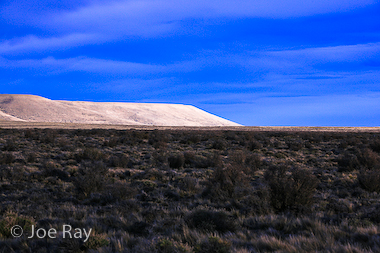
This is not a drive for the faint of heart or the short on time. The spiritual, wild-eyed cousin to Route 66, Patagonian Argentina‘s Ruta 40 is a ‘Mad Max’-style dirt road to nowhere, skirting the Andes, connecting only north and south, with rib-like smaller roads reaching out to the major stopping points along the way. Here, “luxury travel†is a dependable 4X4 with plenty of clearance. Plan on dings in the windshield and the ride of your life.
The hit list is diverse: Cueva de las Manos, the mammoth Perito Merino Glacier which calves building-sized chunks of ice into Lago Argentino, some of the world‘s best hiking, fly fishing and outdoor activities. Even driving to parts of Patagonian Chile like Torres del Paine National Park with craggy granite peaks that reach 3000m, requires passing through Argentina; two countries share one road toward the end of the world.
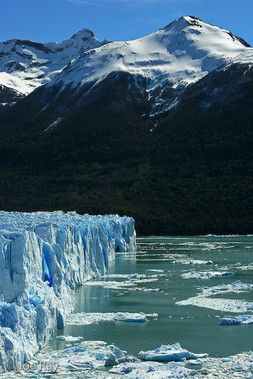 The mammoth Moreno Glaciar meeting Lago Argentino near the Argentine town of El Calafate - Photo by Joe Ray
The mammoth Moreno Glaciar meeting Lago Argentino near the Argentine town of El Calafate - Photo by Joe RayGet it while you can. ‘Progress’ is coming in the form of asphalt. The paving of Route 40 in Patagonia is a political promise supported by former President Nestor Kirschner along with current president, Cristina Fernandez, Kirschner’s wife. For now, however, Ruta 40 remains wild.
In northern Patagonia, Trevelin is one of a handful of far-flung Welsh settlements colonized here in the late 1800s. Hardship was commonplace, but settlers met for tea and tarts as a way to maintain their heritage. Today, Welsh tea houses are a Patagonian tradition. We stop at the Nain Maggie tea house for an afternoon tea, accompanied by a meal‘s worth of homemade breads, scones, tarts and cakes like the dark torta negra.
“We have no machines in the kitchen,†says Nain Maggie owner, Lucy Underwood, descendant of some of the town‘s founders. Save a stove, the kitchen where she works with her son and daughter is absent of signs of the industrial age. The closest thing to a measuring cup is a Tupperware mug used to scoop flour.
Mixing is done with wooden spoons and the kneading by hand– no small feat considering the number of locals and tourists who come through every afternoon. “The apple tart is apple, sugar, flour and eggs. The cream tart has cream and a little sugar. It’s simple,†she says. “This is the way my family ate.†If ever a weary traveller needs a taste of home, Underwood‘s tarts are direct links to grandma‘s kitchen table.
Heading south, the road dissolves into the nothingness of the steppe – no buildings, no lights, no other cars. For hours upon hours, it’s just you and the nandus (the ostrich-like rhea), deerlike guanacos and the occasional armadillo, all framed with tufts of grass, mountains and mesas, stars and sunsets.
Cholila is nothing on the map and after years of fast horses, robberies and life on the lam, this was a big part of the draw for Butch Cassidy and the Sundance Kid who holed up here the early 1900s, looking to put hold-ups in their past and earn an honest living as ranchers. Their cabin is far from everything and even current-day fugitives would be wise to hide here.
Caretaker Daniel Sepúlveda, who though not “grogged out of his mind,“ as In Patagonia writer Bruce Chatwin described his father, is still off-kilter, like he’s been riled from a nap.
He meets us at the gate, now ironically adjacent to the Cholila police station, and drives the short distance to the cabin while we follow on foot.
Showing us through the slightly-refurbished cabin, he suddenly jerks one of the wooden window blinds open and, eyes wide, pokes his gun-shaped fingers out the window, Sundance-style, as he apparently mows down some Argentine police or bounty hunters. Perhaps he’s honing the presentation for a tour group of the future, but I lose interest, sacrifice my partner to him and wander off to snap photos and contemplate what life was really like here.
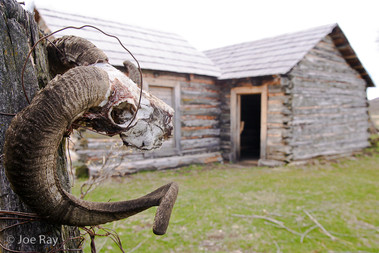 Outside of the ranch where Butch Cassidy and the Sundance Kid holed up near Cholila in the early 1900s. Photo by Joe Ray
Outside of the ranch where Butch Cassidy and the Sundance Kid holed up near Cholila in the early 1900s. Photo by Joe Ray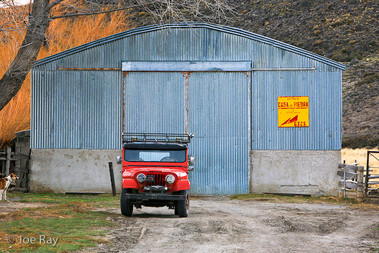 Outside an estancia along Ruta 40. Photo by Joe Ray
Outside an estancia along Ruta 40. Photo by Joe RayThis isolation and unforgiving terrain has spawned a big list of standard supplies for a trip down La Cuarenta that include two full-sized, easily-accessed spare tires, camping supplies, extra food, fuel and oil.
Equipped with all of the above, we still learn the wisdom of preparedness in short order. Thick snowflakes begin falling seventy kilometers into the access road toward Perito Moreno National Park, famous for pristine steppe, glacial peaks, surreal blue lakes and a guanaco population that wildly outnumbers the
visitors. (A scant 1,200 people visit each year and in early spring, we are the first in weeks to sign the guestbook.) Our planned lodging – Estancia Menelik – one of thousands of lonely ranches that populate Patagonia, is still closed for the season. Caretaker Manuel Pardo, known as Don Manuel, generously invites us in
for a maté.
Sitting quietly as the snow falls, we talk and sip the herbal drink from a gourd for two hours. Time and conversation flow, contract and flow again.
Coming from the world of industrialized food and wanting to know more about what makes Argentine beef so famous, I ask what a cow’s life is like here and Don Manuel clearly doesn‘t understand. Finally, he gestures toward the window and the 10,000 lonely hectares that belong to the ranch. “That’s their life.â€
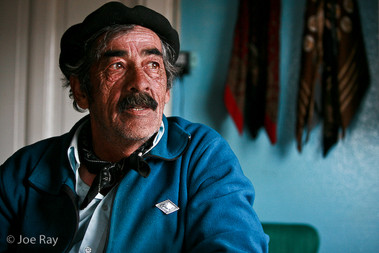 Argentine gaucho Don Manuel Pardo, caretaker at Estancia Menelik near Argentina’s Perito Moreno National Park. Photo by Joe Ray
Argentine gaucho Don Manuel Pardo, caretaker at Estancia Menelik near Argentina’s Perito Moreno National Park. Photo by Joe Ray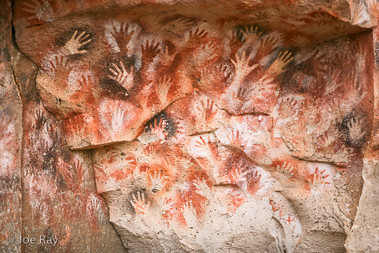 A scene at UNESCO-classified Cueva de Las Manos - Cave of The Hands. Photo by Joe Ray
A scene at UNESCO-classified Cueva de Las Manos - Cave of The Hands. Photo by Joe RayWe emerge to discover I’ve left the truck lights on and Don Manuel brushes a few inches of fresh snow from the hood of his truck to give us a jump.
We ask about the road.
“You’ve got four-wheel drive, right?â€
“No.â€
“Ah. Well, that’s ok. You‘ve got chains, right?“
“No.â€
“Ah.â€
Before we realize we’re stuck, he offers a place to stay.
Don Manuel is one of the last of a slowly-dying breed. Argentina‘s version of the American cowboy, gauchos tend to be solitary men whose understanding of the land and its animals comes from a lifetime of experience. There are traces of cowboy attitude, but gauchos are gentlemen ranchers, first and foremost.
By now, the inconveniences of driving La Cuarenta have become the charms. Separated by a lot of time on rough road known as ripio as the only practical means of getting around, each leg is a voyage into a vanishing point, each destination an island where function and beauty worked themselves out decades or eons ago. Though Chatwin’s approach to In Patagonia might strike the reader as a cubist-style set of unrelated vignettes, there‘s a reason: that‘s what it‘s like here.
Not far from a ghost town, tumbleweeds cross main street undisturbed at high noon in Gobernador Costa, population 2000. We wonder what it must be like to grow up so far away from everything, in these strangely nuclear places in the middle of all this space.
We picnic on the merry go round in an empty playground and a shy kid comes to play on the ailing swing set. We say hello and ask his name – Elias – before returning to our eating and swinging. His eyes rarely leave us. Ten minutes later, he holds his hand in the air and lobs a pair of tiny rectangles our way – Bazooka bubble gum.
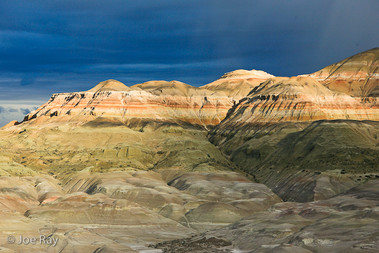 Stratified hills surrounding the Petrified Forest near Sarimento. Photo by Joe Ray
Stratified hills surrounding the Petrified Forest near Sarimento. Photo by Joe Ray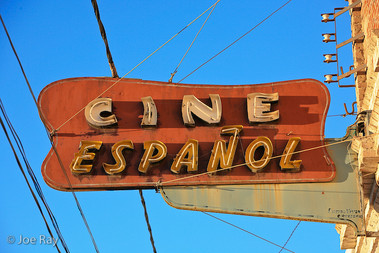 Cinema in Sarimento. Photo by Joe Ray
Cinema in Sarimento. Photo by Joe Ray
He edges closer, hopping atop of a slide, staring, smiling – a quiet, playful curiosity for the outsider. Later, sensing our departure, he beckons us around the corner. “That’s my house!†he says, pointing. “You can come and visit me!†We pack up and Elias reappears with an old Kodak 110 camera to take our picture.
Memory captured.
Later, we visit the UNESCO World Heritage Site, Cueva de las Manos, named for the hundreds of hands painted on the walls 10,000 years ago by nomadic hunters who congregated here. A guide walks us through, explaining the art that also shows how hunters surrounded and killed guanacos and ñandús, but equally inspiring is having this place to ourselves. Except for the most popular sites, similar solitude is found in almost every national park we visit along the way.
For those seeking this disconnect, a paved Ruta 40 is a nightmare that risks drying up towns like Gobernador Costa and their quirky experiences, or turning them into awkward hubs focused on moving tour buses to the next Cave of the Hands-style monument. On the coast, Ruta 3 lurks like 40’s evil twin and a Ushuaïa and Buenos Aires, populated by antique, fume-belching 18-wheelers and long lines of cars, dying to pass.
Though there are still hundreds of unpaved miles north and south of El Chaltén, a big stretch of new pavement links it with the town of El Calafate and the Perito Moreno Glacier. Thrown together in 1985 during a border dispute with Chile, El Chaltén feels like a cross between a military base and a bourgeoning tourist draw.
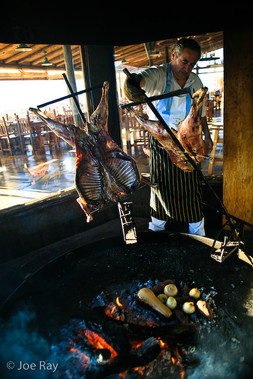 Inside the grill at parrilla Don Pinchon in El Calafate, Argentina. Photo by Joe Ray
Inside the grill at parrilla Don Pinchon in El Calafate, Argentina. Photo by Joe Ray
Though resident Paulo Gallego, a guide who specializes in bringing hikers into the nearby Los Glaciares National Park, profits from increased accessibility brought by Ruta 40, he‘s at odds with the rapid expansion it brings.
“There’s an amazing quality of life here, but the growth gets to be a disaster. It’s no good for us and no good for the tourists,†he says.
“Nothing is planned. All the streets are broken and when they fix the streets, they break the gas lines!â€In early spring, the town sits deep in mud. Considering the town’s year-round population of 600, there’s an amazing amount of hotel and restaurant construction. Even a visitor could detect a whiff of chaos in the air. “Without pavement, it makes it so only the people who really want to get here come,†adds Gallego. “When you pave Route 40, you lose the essentials.â€
Ahead is the slog north on Ruta 3. It will take a couple days to cover the same amount of ground we drove in a few weeks. The miles will seem unearned. Already, I miss the rumble of the dirt road and the slowing of time.
Joe Ray
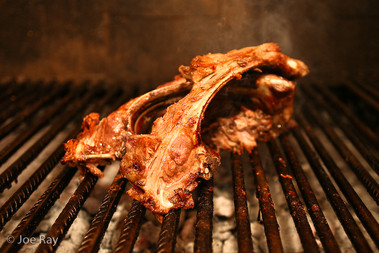 Grilled lamb ribs on one of the grills at parrilla Don Pinchon in El Calafate. Photo by Joe Ray
Grilled lamb ribs on one of the grills at parrilla Don Pinchon in El Calafate. Photo by Joe Ray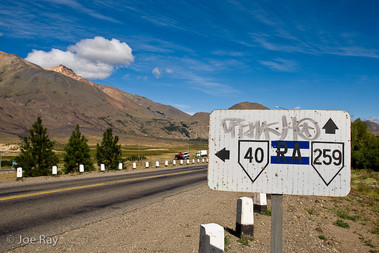 Near Bariloche a road sign for La Cuarenta. Photo by Joe Ray
Near Bariloche a road sign for La Cuarenta. Photo by Joe Ray
If you go…
LODGING
Helsingfors Estancia
Sitting equidistant between El Chalten and El Calafate, Helsingfors offers luxury accommodations on the Lago Viedma inside the Los Glaciares National Park. Horseback and foot expeditions head out regularly, as does a trip to the Viedma Glacier via Zodiac.
http://www.helsingfors.com.ar
.(JavaScript must be enabled to view this email address)
Buenos Aires office:
Av. Córdoba 827, piso 11, depto. „A“
C1054AAH - Buenos Aires
+54-11-4315-1222
Los Notros
Situated in the Los Glaciares National Park, the address given on their Web site simply reads, “Facing the Perito Moreno Glacier.“ Here, ‘the glacier‘ spills into the Lago Argentino, all framed by the picture windows in every room.
http://www.losnotros.com
.(JavaScript must be enabled to view this email address)
+54-2902-499510
Hotel Indigo
In Chilean Patagonia, Puerto Natales is the launch point of the Torres del Paine National Park and luxurious Indigo was conceived as a place to begin or end several days of intense hiking.
http://www.indigopatagonia.com/uk/
.(JavaScript must be enabled to view this email address)
Ladrilleros 105
Puerto Natales, Chile
+56-61-413609
EXPLORING
Hielo & Aventura
This well-respected guide service based in El Calafate offers a “Big Ice“ journey (and small-group) journey atop the Perito Moreno Glaciar.
http://www.hieloyaventura.com
.(JavaScript must be enabled to view this email address)
Av. Libertador 935
El Calafate
+54-02902-492205
FLY FISHING
Guide Alejandro Leutgeb runs an exclusive fishing operation out of the northern Patagonia gateway town of Bariloche. Floating down the Limay and Manso rivers in the Nahuel Huapi National Park, fly fisherman chase several species of trout, landlocked salmon and native perch.
.(JavaScript must be enabled to view this email address)
+54-92944-582473
DINING
La Tablita
Wildly popular and for good reason, El Calafate‘s La Tablita is one of the best parrillas (steakhouses) along Ruta 40. Reserve ahead or wait in line. For a more modern twist on the art of grilling, try Don Pinchon, just up the hill.
http://www.interpatagonia.com/latablita
.(JavaScript must be enabled to view this email address)
Coronel Rosales 28
El Calafate
+54-02902-491065
Kaupé
If you‘ve come to the end La Cuarenta, you may well want to continue to the city at the end of the world and have a meal at one of Argentina‘s best restaurants. Overlooking the Beagle Channel, chef Ernesto Vivian serves local seafood, including several variations of his specialty - king crab.
http://www.kaupe.com.ar
Roca 470
Ushuaia
+54-2901-422704
See the .pdf version of this story as it ran in American Express Platinum Magazine here